英汉翻译-5增补与省略
- 格式:ppt
- 大小:1.03 MB
- 文档页数:66

谈英汉翻译技巧中的增补与省略【摘要】增补法是英汉翻译中常用的方法之一。
所谓增补,就是为了使译文准确和符合汉语习惯,译者应该添加必要的词句。
所谓省略法,就是将不必译的冠词、物主代词、连系动词等省略不译。
【关键词】翻译技巧增补法省略法英汉翻译是英语学习中最基本的技能之一,在今天的飞速发展的世界中越来越显示出它的重要性。
一篇好的译文应该是既忠实于原文,又符合汉语的用法习惯,并且在内容与形式上与原文达到辩证的统一。
忠实于原文是翻译中最重要的一点。
但由于英汉两种语言的巨大差异,“忠实”的涵义并不是逐字逐句地照搬原文,而是“忠实地表达”原作者的思想,准确地理解和恰当地表现原文。
因此,译者必须在理解原文的基础上,运用恰当的翻译技巧,将原文译出。
英汉翻译技巧一般来说有8种,即“分清主从”,“选词用字”,“增补法”,“省略法”,“词性转换”,“词序调整”,“正说反译和反说正译”以及“长句拆译”。
本文侧重谈谈英汉翻译技巧中的增补与省略这两种方法。
1.增补法增补法是英汉翻译中常用的方法之一。
增补不是给原文增加某些内容,而只是翻译中的一个必要的规则。
它实际上主张,为了使译文准确和符合汉语习惯,译者应该添加必要的词句。
增补法在下面几种情况下经常使用:A.当某些词在英语的句子中被省略时例如:We can get rid of a bad style and keep the good.虽然,在good 一词后省略了style.这句可译成:我们能够去掉不良作风,保持优良作风。
He majors in English and l in French.在I 后面省略了动词major.这句应译成:他主修英语,我主修法语。
在这类句子中,原文省略的部分应在译文中写出来。
B. 当英文中用代词来避免重复时例:Her room is lighter than the one next door.代词one 代表room.这句应译成:她的房间比隔壁那间亮堂。
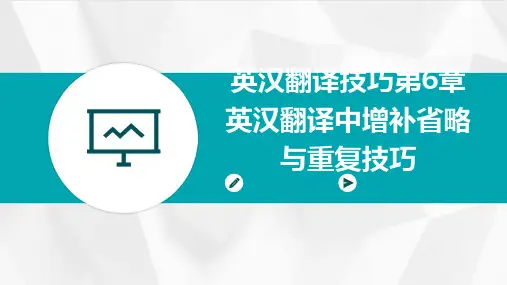
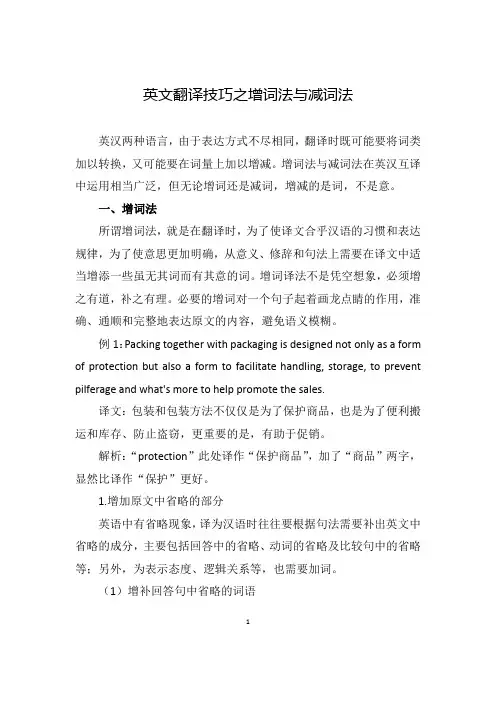
英文翻译技巧之增词法与减词法英汉两种语言,由于表达方式不尽相同,翻译时既可能要将词类加以转换,又可能要在词量上加以增减。
增词法与减词法在英汉互译中运用相当广泛,但无论增词还是减词,增减的是词,不是意。
一、增词法所谓增词法,就是在翻译时,为了使译文合乎汉语的习惯和表达规律,为了使意思更加明确,从意义、修辞和句法上需要在译文中适当增添一些虽无其词而有其意的词。
增词译法不是凭空想象,必须增之有道,补之有理。
必要的增词对一个句子起着画龙点睛的作用,准确、通顺和完整地表达原文的内容,避免语义模糊。
例1:Packing together with packaging is designed not only as a form of protection but also a form to facilitate handling, storage, to prevent pilferage and what's more to help promote the sales.译文:包装和包装方法不仅仅是为了保护商品,也是为了便利搬运和库存、防止盗窃,更重要的是,有助于促销。
解析:“protection”此处译作“保护商品”,加了“商品”两字,显然比译作“保护”更好。
1.增加原文中省略的部分英语中有省略现象,译为汉语时往往要根据句法需要补出英文中省略的成分,主要包括回答中的省略、动词的省略及比较句中的省略等;另外,为表示态度、逻辑关系等,也需要加词。
(1)增补回答句中省略的词语1例2:—He doesn’t know, does he?—Yes, he does.译文:——他不知道吧?——不,他知道。
例3:—Did you enjoy your time in Beijing?—Yes, I did.译文:——你在北京过得愉快吗?——是的,我过得很愉快。
(2)增补并列结构中省略的词语例4:On average, the economy performs less well in a president's second term than in his first.That pattern probably does not apply to Mr Obama. Since his first term was so difficult, the next, by rights, ought to be better.译文:一般来说,美国总统第二个任期内的经济不如第一任期。
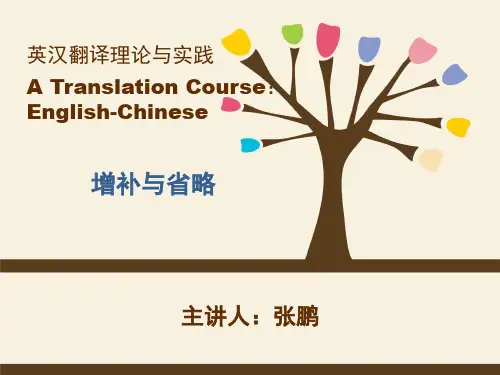
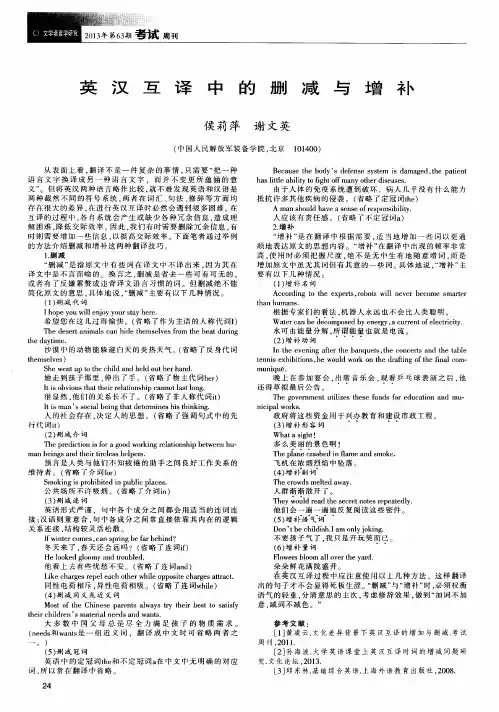
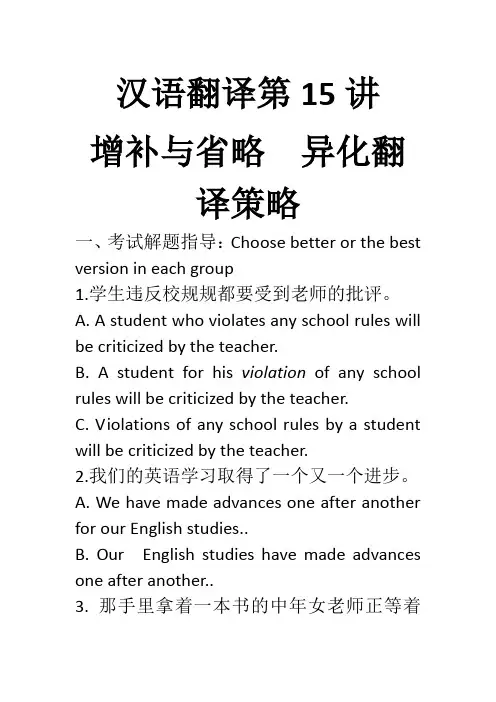
汉语翻译第15讲增补与省略异化翻译策略一、考试解题指导:Choose better or the best version in each group1.学生违反校规规都要受到老师的批评。
A. A student who violates any school rules will be criticized by the teacher.B. A student for his violation of any school rules will be criticized by the teacher.C. Violations of any school rules by a student will be criticized by the teacher.2.我们的英语学习取得了一个又一个进步。
A. We have made advances one after another for our English studies..B. Our English studies have made advances one after another..3. 那手里拿着一本书的中年女老师正等着学生讨论问题。
A.The aged woman with a book in her handis waiting for the students to discuss a problem.B. The middle-aged is waiting for the students to discuss a problem., holding a book in her hand.C. The middle-aged woman teacher holding a book in her hand is waiting for the students with whom she will discuss a problem.4.请全体学生,于明天在会议室开会。
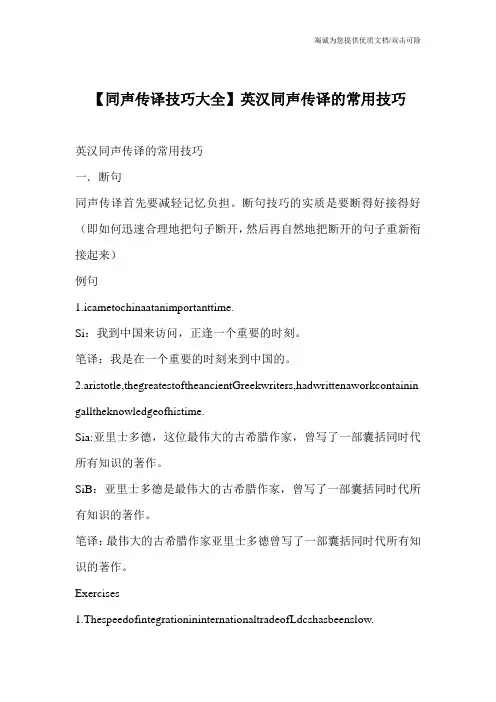
【同声传译技巧大全】英汉同声传译的常用技巧英汉同声传译的常用技巧一.断句同声传译首先要减轻记忆负担。
断句技巧的实质是要断得好接得好(即如何迅速合理地把句子断开,然后再自然地把断开的句子重新衔接起来)例句1.icametochinaatanimportanttime.Si:我到中国来访问,正逢一个重要的时刻。
笔译:我是在一个重要的时刻来到中国的。
2.aristotle,thegreatestoftheancientGreekwriters,hadwrittenaworkcontainin galltheknowledgeofhistime.Sia:亚里士多德,这位最伟大的古希腊作家,曾写了一部囊括同时代所有知识的著作。
SiB:亚里士多德是最伟大的古希腊作家,曾写了一部囊括同时代所有知识的著作。
笔译:最伟大的古希腊作家亚里士多德曾写了一部囊括同时代所有知识的著作。
Exercises1.ThespeedofintegrationininternationaltradeofLdcshasbeenslow.ernmentshaveacrucialroletoplayinpromotingsocialhumandevelopme ntandinprovidingthepoorwithnecessaryworkingskills.3.Theywillgetthepreparationdonebeforeconsideringotherproposals.(反说)4.weshallvoteonthedraftdecisionafterwehavevotedontheamendments.(反说)二.词性转换由于英汉两种语言在表达方式上的差别,也由于同传中顺句驱动的需要,适当的词性转换可以使译文通顺自然。
特别是英语非动词(包括名词,形容词,介词,分词等)转成汉语动词,可以说是英汉词性转换中使用最多的类型。
例句见课件Exercises1.abetterknowledgeofthelocalculturewillhelpourwork.2.implementationofinternationalhumanrightsstandardsisextremelyimporta nt.3.Theywanttousemilitaryforceagainstso-calledterroristcountries.(介-动)4.Youandyourcountrywagedalongstruggleforsocialjustice.(介-动)5.Reformersneedtangibleevidenceofrisinglivingstandards.三.等待指的是在Si中有意识地等一下,等到上下文较清楚时才开口翻译。
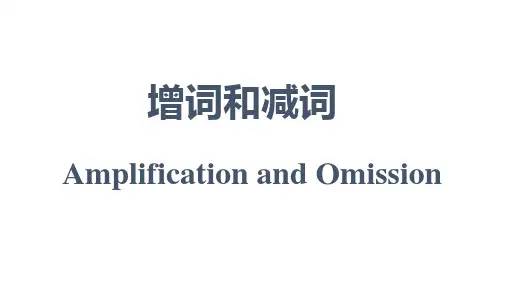
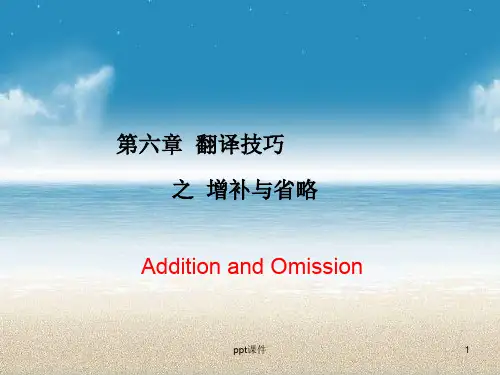
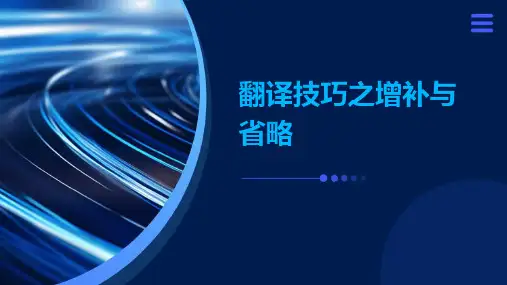
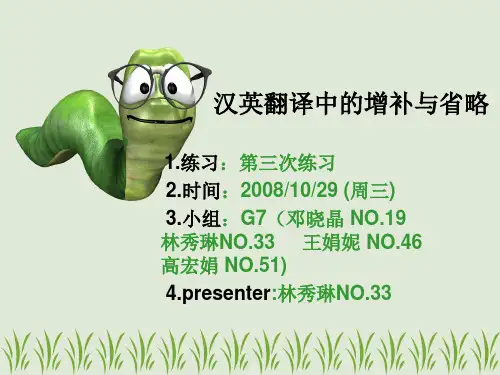
浅谈增词法、省略法在英汉翻译中的技巧李凯玉A Study of Amplification and Omittion inEnglish-Chinese Translation SkillsLi Kaiyu摘要:文字的增补与省略,并不是说在原文思想内容之外,再增加什么意思或减少什么意思,而是说,在保证译文和原文意思完全一致的前提下,在字面上作一些补充或删减,其目的是使译文更加真实流畅。
在翻译中,有些词在特定词组中失去具体实义,仅仅表明范畴,想“态势”、“状态”、“问题”、“局面”等,按我们汉语的搭配习惯,组成“以实带虚”相对的固定词组。
象“衣食住行问题”、“听天由命的心态”、“贫穷落后的状况”等。
英语和汉语表达方式不一样,他习惯使用抽象名词来表达与汉语词组相同的意思,所以翻译的时候要注意。
关键要根据上下文,确定这些词在句子里是否具有实在的意义,则省略不译,以免产生累赘。
这是最忌讳的!关键词:增词;省略;翻译Abstract: With the addition of the words omitted, it does not mean that the original ideological content, the increase or decrease in the meaning of what it meant, It said that to ensure translations and the original meaning is fully consistent with the premise that literally make some additions or delete. The purpose is true: more fluent. In translation, some words have lost their specific real justice in a particular phrase, merely indicates areas like "ours" and "state" "problems" and "situation", according to our customary mix of Chinese, "which in real modest" relative to the fixed phrase. Like "green" and "fatalistic mentality," and "the situation of poverty and backwardness." English and Chinese expression is not, he used abstract terms with the Chinese phrase to express the same meaning. Therefore, we must pay attention to the translation. The key to the light of the context, the possibility of determining these words have real meaning of the sentence., it cannot be translated. In order to avoid cumberance. This is the most taboo!Key words:Amplification; Omitted; Translation引言翻译是一种跨越时空的语言活动,是“一种语言已经表达出来的东西用另一种语言完整而准确的表达出来。
增补与省略增补与省略是翻译中最为常见的又一技巧,又称为增词译法和减词译法。
这一技巧的使用原则是增词不增义,减词不减义,而是使意义能够更加明确,文字更加通顺。
一.增补法:根据增补的情况不同,我们将之分为语义增补、语法增补和修辞增补。
(一)语义增词:1.英语有时用词很简洁,在翻译时要增加原文字面上没有、而意思上包含的字词,以免导致语义含糊或歧义。
⑴ The crowds melted away.人群渐渐散开了。
评析:原文中并没有“渐渐”一词,但melt含有渐渐融化、渐渐散尽的意味,因此在译文中加入了“渐渐”这样一个状语。
⑵ As he sat down and began talking, words poured out.他一坐下来就讲开了,滔滔不绝地讲个没完。
⑶ Ideally, one day, researchers will know enough about the genesis of earthquakes and the nature of particular faults to predict quakes directly.最理想的情况是,有朝一日研究人员能够对地震的成因及具体断层的性质有足够的了解,从而能够直接预报地震。
英语习惯运用抽象词汇,而汉语习惯运用具体词汇。
在翻译时若要将抽象概念变为具体概念,则需要增加解释说明的词语。
⑷ We were all greatly moved by his loftiness.我们都被他那种崇高品质所深深感染。
评析:loftiness是一个表达抽象概念的词,在译成汉语时需要添加词汇,使之符合汉语习惯,诸如此类转换,比比皆是。
如对arrogance, indifference, tension等词的翻译,都需要增词。
⑸ He felt the patriot rise within his breast.他感到一种爱国热情在胸中激荡。
⑹ He allowed the father to be overruled by the judge, and declared his own son guilty.他让法官的职责战胜了父子的私情,判决他的儿子有罪。
Omission指省去那些在译文中不言而喻的字词,或省去那些译出来反而会显得突兀、累赘或不合汉语的表达习惯的词语。
(一)省略人称代词一般说来,英文的句法比汉语严格,每个句子一般都有完整的主谓宾。
而汉语的表达习惯则往往会在指代关系明确的情况下,几个谓语借用上下文提到一个共同的主语,不必一个个重复,因此,作主语及作宾语的人称代词汉译时往往会省略。
如:Give him an inch and he?ll take an ell.得寸进尺。
Follow the river and you will get to the sea.顺藤摸瓜。
(二)省略物主代词英语用物主代词多于汉语。
如:She puts on her clothes.她穿上衣服。
(三)省略非人称代词用来表示时间、天气、自然环境或距离的非人称代词it,用来代替不定式短语或从句作形式主语的先行代词it,和强调句式中的it,汉译时往往省略。
如:It was a cold morning of spring when I went to see her.我在一个寒冷的春天早晨去见她。
—What day is it today?—It is Saturday.—今天星期几?—星期六。
(四)省略并列连词,and和or如:This little room is warm and cosy.这个小房间温暖舒适。
She wentsintosthe room and closed the door.她走进房间,关上门。
All I am,or can be,I owe to my angel mother.我之所有,我之所能,都归功于我慈爱的母亲。
(五)省略从属连词汉语中的逻辑关系往往是隐含在句子含义中的,由语序加以体现。
因此,英语中一些表示原因、条件或时间的从属连词有时可省略。
如:Because everyone uses language to talk,everyone thinks he can talk about language.人人都用语言交谈,人人也就自认能够谈论语言。